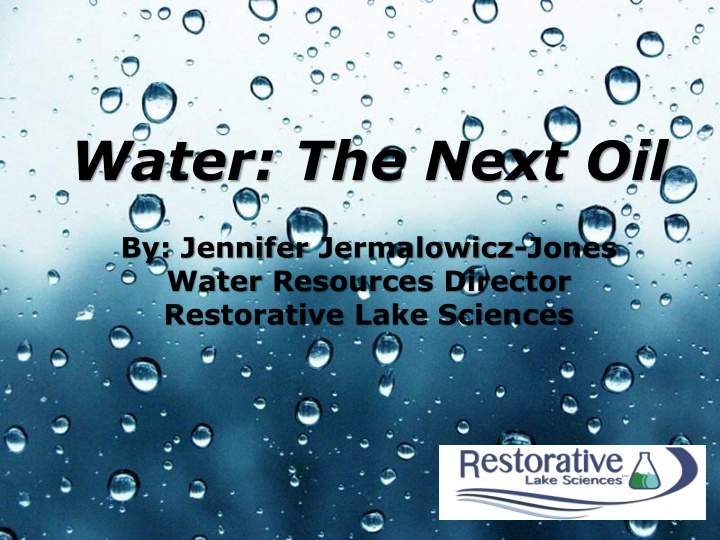



Powerpoint Templates Water: The Next Oil By: Jennifer Jermalowicz-Jones Water Resources Director Restorative Lake Sciences Powerpoint Templates Page 1
Something to Ponder …. Powerpoint Templates “Edward Mazria, a climate -conscious architect from New Mexico who has launched the 2030 Challenge describes its ultimate goal to get U.S. architects to design all buildings by 2030 to operate without fossil fuels. He notes that: “It’s the architects who hold the key to turning down the global thermostat”. From: World on the Edge, by Lester R. Brown (2011) Page 2
Something Else to Ponder …. Powerpoint Templates In other words…..we can make a difference at the local scale. Collective actions lead to improvements at a global scale! Page 3
More on Freshwater Availability: Powerpoint Templates Page 4
Global Freshwater Availability: Powerpoint Templates Page 5
Modernized Drought Data: Powerpoint Templates Page 6
The Water Profile on Earth: Powerpoint Templates Page 7
Global Water Use: Powerpoint Templates Source: climate.org Page 8
Household Water Use: Powerpoint Templates Page 9
Individual Septic Systems: Powerpoint Templates Source: EPA Page 10
Ways to Conserve Water: Engineering & Behavioral Powerpoint Templates Limit toilet flushes or better, use a compost toilet (did you know that each flush uses 5-7 gallons of water!?) Reduce shower times Reduce burden on water softeners Limit use of garbage disposal or compost scraps Reduce “wait periods” for water temperature changes Reduce dishwater and washing machine use Shut off fawcet when brushing teeth Reduce need for lawn watering-go natural! Reduce need for ornamentals/garden watering:collect rain water Bottled water requires water to produce plastic bottles! Drink from tap Recycle “gray water” for future uses Alter bath and kitchen fittings to reduce gpm Keep yard vegetated since this reduces soil temperatures and moisture loss Use mulch or peat on garden areas to reduce watering needs Page 11
Phytoremediation Defined: Powerpoint Templates • The use of vegetation to contain, sequester, remove, or degrade organic and inorganic contaminants in soils, sediments, surface water, and http://ideonexus.com/wp-content/uploads/2008/05/phytoremediation02.jpg groundwater Page 12
Phytoremediation- Powerpoint Templates Advantages vs. Disadvantages Advantages Disadvantages Can attract nuisance wildlife • Sustainable, low- May require more land than maintenance traditional technologies • Control erosion, runoff, Incompatibilities with root infiltration, dust emissions depth and access to • Earth-friendly (especially if pollutants solar-powered) Time-demanding • Minimal water discharge, Susceptible to seasonal and secondary waste diurnal variations • Create volunteer & education opportunity • Applicable in remote locations Page 13
The Phytoremediation Process (in general) Powerpoint Templates http://www.mobot.org/jwcross/phytoremediation/graphics/Citizens_Guide4.gif Page 14
Conclusions Powerpoint Templates • Plants are powerful vehicles in the reduction of pollutants in soils, groundwater, surface water, or sediments • Solution limitations are not well-known due to recent onset of technology • Solution(s) must be compatible with sites and intended purpose given pollutant type and source • A monitoring program is recommended to measure efficacy over a long-term period Page 15
Low Impact Development (LID) Powerpoint Templates • Reduces imperviousness (11% less impervious area = 98% reduction in runoff volume) • Reduces runoff quantity • Improves runoff quality • Reduces erosion and soil loss • Creates biodiversity Page 16
NPS Categories (EPA) Powerpoint Templates • Acid Mine Drainage • Agriculture • Forestry • Hydromodification/Habitat Alteration • Marinas/Boating • Roads, Highways, and Bridges • Urban – Low-Impact Development* • Wetland/Riparian Management Page 17
LID Examples: Powerpoint Templates • Green spaces/Roofs • Reduction of impervious surfaces • Bioretention • Flatten slopes • Disperse drainage systems • Vegetative swales • Increase distance from streams • Reforestation • Water reuse Page 18
Filtration/Bioretention Basin Powerpoint Templates Page 19 Photo Credit: Neil Einstein
Runoff Reduction from Basin: Powerpoint Templates Page 20
Impervious Cover: Powerpoint Templates • Impervious cover is defined as “Any surface in the urban landscape that cannot effectively absorb or infiltrate rainfall; for example, roads, roofs, parking lots, etc.. Fairfaxcounty.gov Page 21
Stormwater Capture: Powerpoint Templates • Cisterns are a great way to collect rain water and reuse for landscaping or indoor water use activities lakecountyil.gov Page 22
Rain Garden Cross Section Powerpoint Templates Cross section of a small residential rain garden, Michigan LID manual Page 23
RECARGA: Powerpoint Templates http://dnr.wi.gov/runoff/models/ Page 24
Green Roofs Powerpoint Templates • Decrease building temps (and need for much AC); By as much as 40-50 degrees F • Decrease runoff volume and Increase runoff water quality Page 25
Benefits of green roofs Powerpoint Templates Page 26
Types of Green Roofs: Powerpoint Templates Page 27
Modular systems Powerpoint Templates • GreenGrid • Green Roof Block System Page 28
Eight Tools of Watershed Protection Powerpoint Templates • Watershed/Land Use Planning • Land Conservation • Aquatic Buffers* • Better Site Design* • Erosion and Sediment Control* • Stormwater Management • Non-Stormwater Discharge* • Watershed Stewardship Page 29
Treatment of “Gray Water” Powerpoint Templates Gross et al. 2007 Page 30
Global Annual Freshwater Withdrawals: Powerpoint Templates Total Freshwater Withdrawals 3000 U.S. alone: 482.2 2500 2000 km3 per year Total Freshwater 1500 Withdrawals 1000 500 0 Africa North and South Asia Europe Oceania Source: www.worldwater.org Central America America Page 31
Pollutants in Inland Lakes: Powerpoint Templates • Nutrients (P, N) • Solids (TDS, TSS, Soils) • Metals (Arsenic, lead, etc..) • Cyclic organics (PCB’s, oils, etc..) • Other toxins (Cyanide*) Page 32
Impacts of Pollutants in Inland Lakes: Powerpoint Templates • Nutrients (P, N) = eutrophication (increased weed/algae growth) • Solids (TDS, TSS, Soils) = decrease in water clarity and depth • Metals (Arsenic, lead, etc..) = accumulation of metals in sediments • Cyclic organics (PCB’s, oils, etc..) = bioaccumulation and bio-magnification of toxins in higher life such as fish, humans • Other toxins (Cyanide) = even low doses are TOXIC to many forms of aquatic life Page 33
Powerpoint Templates Page 34
Powerpoint Templates Page 35
Powerpoint Templates Page 36
Websites for Useful H2O Conservation: Powerpoint Templates • http://www.plumbinginfo.ca/tag/water-conservation/ • http://water.epa.gov/polwaste/nps/chap3.cfm • http://www.naturesvoice- ourchoice.org/conservation-devices/72.html • http://35.9.116.206/IWR/brochures/HIT.pdf • http://www.worldwater.org/data.html • http://www.climate.org/topics/water.html • http://www.watercache.com/education/grayw ater/ Page 37
Websites for Useful H2O Conservation: Powerpoint Templates • http://www.ecoinstitution.com/green-news/helping- people-green-their-homes-2/ Page 38
Questions/Comments ? Powerpoint Templates Page 39
Recommend
More recommend